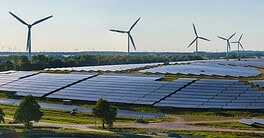Increasingly, the path to net-zero buildings and facilities begins in the CFO’s office.

The world must achieve zero carbon dioxide emissions by 2050 to stave off further climate disaster, according to the 2015 Paris Agreement. Buildings are the largest source of emissions of any sector, accounting for 40% of energy-related global carbon emissions. Yet, only 3% of investment in new construction is currently green and efficient.
Big as the challenge is, climate change is typically classified as a regulatory issue: the domain of compliance and sustainability officers, engineers, and designers.
For building owners, developers, and REITs, “it’s the responsibility of CFOs and their team to maintain financial viability and to steer a company’s portfolio decisions,” says Julie Emmrich, sustainable finance lead at the World Green Building Council (WorldGBC). “There needs to be close communication between finance and other stakeholders to understand the economics of future-proofing a building.”
When it comes down to the financial management of building companies, the WorldGBC identifies several reasons why CFOs should care about building green, including the potential for greater access to investment, improved corporate reputation, higher asset value and desirability, resilient investment and lower risk of stranded assets, increased ROI, and preferential insurance premiums.
Green buildings can also amass substantial cost savings. In North America, Leadership in Energy and Environmental Design (LEED)-certified buildings reported $1.2 billion in energy savings, $715.3 million in maintenance savings, $149.5 million in water savings, and $54.2 million in waste savings from 2015 to 2018. Other savings come from lower remediation or refit costs and potential federal, state and local government tax benefits.
Ignoring Net Zero Risky
Beyond the benefits of building green, CFOs need to be aware that the financial risks of ignoring a net zero carbon agenda can be significant now that more governments are cracking down. In France, landlords can no longer increase rent on properties with poor energy efficiency ratings, and as of January 1, it is illegal to rent out the least energy efficient properties: those consuming more than 450 kilowatt hours per square meter per year. In the UK, by 2025, buildings will require Energy Performance Certificates or they cannot be rented out; it’s expected that energy upgrades will apply to 15 million homes in England and Wales, according to Lloyds Banking Group.
Local governments are also weighing in on reducing building CO2. Vancouver, Canada declared a climate emergency in 2019 and set a goal to reduce embodied carbon (carbon from construction materials) 40% by 2030. The city has since established an aggressive building carbon reduction strategy, including new zoning requirements, by-laws, and guidelines for new builds.
In the US, New York City Local Law 97 sets limits on buildings’ greenhouse gas emissions, starting in 2024. As part of the Climate Mobilization Act of 2019, the law aims to help the city reach the goal of a 40% reduction in greenhouse gas emissions from buildings by 2030, and an 80% reduction in citywide emissions by 2050. Some 3,700 properties could reportedly be out of compliance with the new law next year and collectively face more than $200 million per year in penalties. By 2030, this number is forecast to grow to over 13,500 properties that cumulatively could face penalties as high as $900 million each year according to a January 2023 report from the Real Estate Board of New York.
What this demonstrates, says Emmrich, is that policy risk is always on the horizon: “CFOs need to understand that the ROI they calculate today may change very quickly if they don’t consider net zero or ESG considerations.”
Market Forces
Public-company CFOs are also at the mercy of shareholder expectations—and the repercussions that negative perceptions can have on share price.
Consider the value of REITs. Finance teams need to consider how their buildings’ compliance with net zero standards will likely impact future market share, Emmrich cautions, and whether the company is keeping up with its competitors in the transition to net zero.
“Future proofing the business must include an understanding of the demands of investors,” says adds, “and it’s the job of the CFO to ensure that investments or projects are in alignment with market demands.”
Net zero carbon initiatives are also forcing CFOs into new territory with regard to reporting. Evolving reporting regulations place the responsibility for disclosure on environmental, safety, and governance matters in their hands.
In the EU, sustainability issues fall either on the chief sustainability officer or the strategy department, says Lydia Neuhuber, sustainability consulting lead at Deloitte Germany. Over the past two years, however, “this has changed dramatically, and the big driver of that first and foremost is regulation.”
That results from two key moves by EU regulators. “First, sustainability issues are now closely integrated with financial issues,” Neuhuber says. “Take revenues, for example. Suddenly, the sustainability department must report a specific percentage of green revenues overall. That’s resulted in the fact that somebody needs to understand the overall revenues—and that’s the finance function. So, there is this kind of incorporation of the two topics by establishing new KPIs that are regulatorily binding.”
Second, the 2021 Corporate Sustainability Reporting Directive (CSRD) expanded and standardized the sustainability topics that need to be reported on—all of which needs to be audit-assured.
“This is a total shift, because previously, sustainability reports were not standardized and there was no warranty assurance of information,” says Neuhaber. Now, “both the CEO and the CFO are responsible for the ESG information that is communicated to external stakeholders.”
Of course, the finance team isn’t going to solve the challenge of going to carbon net zero by itself, she adds. But it will be up to the CFO, increasingly, to make clear what’s at stake financially and to marshal the troops to take action.
“That’s the core message for CFOs when it comes to sustainability,” says Neuhaber. “What really matters is that the topic is anchored within the entire organization and that net zero is driven forward in a cross-functional way.”



